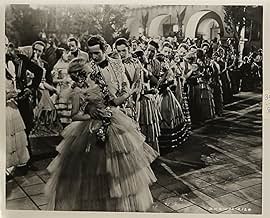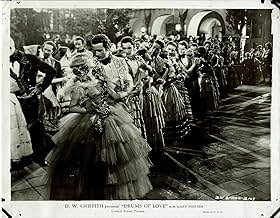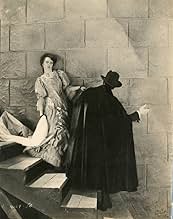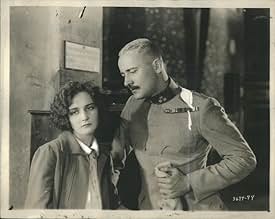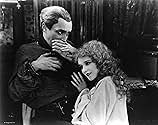Mary Philbin(1902-1993)
- Actress
Mary Philbin's life should be a lesson to domineering parents. Mary was
born on July 16, 1903, in Chicago, Illinois, to John Philbin and his
first wife and namesake, Mary. The child was regarded as a little
beauty from an early age and her mother was exceedingly proud of her
and loved to show her off. Howevr, unlike her gregarious mother (who
many regarded as controlling and domineering, to the point of
imprinting her strict religious beliefs on the child), Mary took after
her shy, quiet and reserved father, whom she adored. Many of her
contemporaries remarked how she didn't seem to belong to the current
age; her personality was a throwback to the 19th century with her
mannerisms and religious, quiet and very gentle nature. Being an only
child, Mary grew up quite spoiled by her mother. Her father would take
her often to see the plays at local theaters and even, on rare
occasion, to see an opera at the Chicago Opera House. She fell in love
with the stage immediately and, once home, would re-enact what she saw
to her dolls--performing the leading heroine roles. She decided at an
early age that she wanted a career in the theater. She took up
classical dancing (ballet and waltz) and was quite adept at playing the
pipe organ and piano (in her later years she kept her family's pipe
organ close at hand), although much to her chagrin, she could not sing.
However, she did not train in an acting school and this would
ultimately impact on her later career.
Mary's early life was relatively uneventful; her mother's strong nature created friction between her parents and she became even more reserved and quite shy in public when meeting new people. The only real friend she had at that age (who would be her lifelong friend and even colleague in The Phantom of the Opera (1925)) was Carla Laemmle (aka Rebecca Laemmle), the daughter of Joseph Laemmle, brother of Universal Studios mogul Carl Laemmle. Through her friend's uncle Mary became interested in films and put her stage career on hold. Upon seeing her first "Nickelodeon", she was bitten by the film bug and eagerly awaited any new ones that came out. She was particularly fond of the films of Erich von Stroheim, so much so that at the age of 16, when she heard that the director was making his new film Blind Husbands (1919) and a contest was set up to search for talent for the film, Mary tried to sign up. At first she could not find the right photograph worthy of submission, but her mother had taken a picture and submitted it and was allowed to join the contest. The contest was held in Chicago at the Elks Club and was sponsored by her church, with Von Stroheim himself as the judge. The Teutonic director was smitten with her beauty and her eagerness to behave and speak well, and gave her the leading role in one of his films. When finding out she was to move to Los Angeles to make the film, Mary at first had reservations and (as always) consulted her parents. Her parents refused until they found out their old family friends, the Laemmles, were moving out to Los Angeles as well, and they gave consent for Mary to go but only with her parents as her chaperones (due to their fear that the "sheiks" of Los Angeles would corrupt Mary's moral character).
Once in Los Angeles, Mary was under watch all the time by her parents (in particular her mother) and, when working, by her new boss, Carl Laemmle. When arriving at the studio, she found out that she had been replaced in the leading role in "Blind Husbands". Mary was deeply hurt at the time and felt cheated, and was considering going home had it not been for her friend Rebecca (whom was now known as Carla) who recommended her to her uncle, the owner of Universal City, Carl Laemmle, and the man in charge of production, Irving Thalberg. Although Carl Laemmle had met Mary some time earlier and always regarded her as an "angelic, sweet, quiet" young lady, he was none too impressed with her at the time to consider her for a contract, owing mostly to her moralistic and reserved disposition. Thalberg held the same reservations about her. However, after being persuaded by Mary's family and Carla, Carl caved and gave 17-year-old Mary her first big part: "Talitby Millicuddy", the leading lady, in the melodrama The Blazing Trail (1921), directed by Robert Thornby. Mary caught on in films very quickly and was considered by the public, initially at least, in the same league as her bigger contemporaries - Mary Pickford, Florence Lawrence, Mae Marsh and Lillian Gish, one of those "child-woman" actresses particularly noted for her subtle but extraordinary ethereal Irish beauty.
After the moderate success of "The Blazing Trail" she was cast in Danger Ahead! (1921) in the role of Tressie Harlow; the one-reel comedy Twelve Hours to Live (1921); the western Red Courage (1921) as Eliza Fay, and Sure Fire (1921) in an extra part (her earliest known surviving film); and False Kisses (1921) as Mary. In all, she made six films in 1921. After seeing her work in "False Kisses" and in particular "Danger Ahead"; Erich von Stroheim cast Mary for his next film, which would become the most expensive (to that date) production ever for Univeral City (the costs rising up to a million dollars) - the part of the crippled girl (an extra part) in Foolish Wives (1922). Mary can be seen in the film as the little girl on crutches with her back turned, and you only quickly get a darkened glimpse of her face through her curly ringlets. Although her role in the film was just a bit part, Mary relished being under Von Stroheim's tutelage and it was from him, as she always said, she learned about "true" acting in comparison to stage acting. It has always been said of Mary Philbin that when the director was really good (such as von Stroheim, Paul Leni, William Beaudine), people noticed she could be equally as good an actress as her colleagues. However, in the hands less talented directors (such as Rupert Julian', - who would partly direct her later in Merry-Go-Round (1923) and "The Phantom of the Opera"--her lack of acting training became a real handicap for her (this is clearly evident in some of her later films).
Mary began to get more notice from Carl Laemmle and Irving Thalberg, after Erich von Stroheim's high recommendation of her (and of course the public's approval), and after a minor film, _The Trooper (1922)_ (v), she was given the role of "Ruth" in Human Hearts (1922). Mary began to get even further recognition and it was around this time that her face always was featured on movie magazines as the 'Cover' Girl. But Mary's personal life was darkened by her father's divorce and remarriage to Alice Mead. Mary was shattered by the event, and as a result became even closer to her mother (her biggest mistake), but nevertheless was very loving to her new stepmother and continued to adore her father.
Mary made two more films before she received her first big break as the heroine "Agnes Urban", in von Stroheim's "The Merry-Go-Round" in 1923. The casting for this film was impeccable and many of its stars would later repeat many films with Mary afterward - in particular her leading man, Norman Kerry. He always had a crush on Mary and flirted with her many times on the set, although von Stroheim, Mary's mother and father (who always were on the set with her; her stepmother stayed at home) and even Mary herself kept him from getting too carried away. Mary said in her later years how deep down she always had a great crush on Norman Kerry and considered him "a very handsome, dashing man". Everything was going well in the production until it came to a standstill for the most unusual and even hilarious reason. Erich von Stroheim was known to be a perfectionist in his work, so much so that in the plot of this film (set in the Austro-Hungarian Empire of the time of 'Emperor Franz Josef') he insisted that some of the actors wear underwear embroidered with the Imperial Austrian Royal Family insignia - infuriating Carl Laemmle. After an intense argument with Laemmle the wildly extravagant director was dropped from the picture. The cast was stunned and the two most affected were Wallace Beery (who was originally cast as Agnes' father) and Mary Philbin. Wallace, infuriated with Carl Laemmle's decision walked out, as did many others--even Mary considered it. To clean up the mess quickly, Carl hired Universal actor Rupert Julian to direct (who previously had directed and starred in The Kaiser, the Beast of Berlin (1918) with Lon Chaney). Mary, at first, refused until Carl insisted that Julian would be just as good a director as von Stroheim. Not having met or worked with Julian before, she decided to stay and Cesare Gravina (a favorite actor of von Stroheim) was re-cast in Beery's role. However, it became clearly evident that Julian was a novice compared to von Stroheim, although he reportedly considered himself equal to, if not better than, von Stroheim in directorial skills. Much of the original footage was cut or re-filmed upon its release, "The Merry-Go-Round" launched Mary as an "official" Hollywood star.
Although not as popular as her contemporaries, Mary graced many more magazine covers and was the feature girl for various products - even the Victrola Recording Company. During this time, Mary met the love of her life, Universal Studio executive/producer Paul Kohner - through the Laemmles. Paul Kohner was only a year older than Mary and born in Teplitz-Schoenau, Austria-Hungary (now Teplice, Czech Republic). They were immediately smitten with each other - but due to Mary's parents' religion (Roman Catholicism) and the fact that Paul was a Jew - they kept their relationship, in the early years, secret as much as possible. They exchanged love letters to each other (which both of them kept till their deaths).
Mary's film career took off with "Where Is This West?"; "The Age of Desire"; "The Temple of Venus"; "The Thrill Chaser"; among others with Paul Kohner sometimes as the producer (affording her more time to be with him, under the protection from her parents observance). But it wasn't until 1924, after she made good in the role of Marianne in The Rose of Paris (1924) that Mary was to be cast in her next, most famous and best- remembered film role of her entire career.
In 1924, Carl Laemmle was searching among the elite list of Hollywood starlets (among those listed were Lillian Gish, Madge Bellamy, Betty Bronson, Patsy Ruth Miller, Mildred Davis) for the role of the young Swedish soprano Christine Daaé in the film adaption of Gaston Leroux's novella "Le Fantôme de l'Opéra" (The Phantom of the Opera) starring in the leading role of Erik (the Opera Ghost/Phantom of the Opera) was one of Hollywood's best actors - Lon Chaney, fresh from his success in The Hunchback of Notre Dame and, much to the concern of the cast and crew, the director hired for the picture was the temper-mental Rupert Julian. Julian remembered Mary from "The Merry-Go-Round" (he also remembered Norman Kerry and hired him for role of Viscount Raoul de Chagny). Mary was cast in the key role of Christine, the chance of a lifetime. But the production was one of the most difficult for the cast to endure. Although Mary was working alongside of many of her former colleagues and friends (Norman Kerry, Cesare Gravina, John St. Polis, and Carla Laemmle), she had never met Lon Chaney personally before and, in keeping with her nature, was initially very shy and nervous around him.
During the filming Chaney and Julian exchanged heated arguments. Charles Van Enger, the main cameraman for the film, commented on how they "just hated each other" and how Julian was obsessed with Mary; adjusting her clothes, wigs, even the padding on her legs and chest. Mary put up with it - because of not only was her mother on the set most of the time, but Julian's wife Elisie Wilson was an old friend of Mary's. Upon seeing Julian's conduct- Elisie took over Mary's wardrobe and makeup for the film. On the Phantom set Mary seldom worked with Chaney alone, most of the time it was under Julian's supervision - but due to Chaney and his arguments
Mary's early life was relatively uneventful; her mother's strong nature created friction between her parents and she became even more reserved and quite shy in public when meeting new people. The only real friend she had at that age (who would be her lifelong friend and even colleague in The Phantom of the Opera (1925)) was Carla Laemmle (aka Rebecca Laemmle), the daughter of Joseph Laemmle, brother of Universal Studios mogul Carl Laemmle. Through her friend's uncle Mary became interested in films and put her stage career on hold. Upon seeing her first "Nickelodeon", she was bitten by the film bug and eagerly awaited any new ones that came out. She was particularly fond of the films of Erich von Stroheim, so much so that at the age of 16, when she heard that the director was making his new film Blind Husbands (1919) and a contest was set up to search for talent for the film, Mary tried to sign up. At first she could not find the right photograph worthy of submission, but her mother had taken a picture and submitted it and was allowed to join the contest. The contest was held in Chicago at the Elks Club and was sponsored by her church, with Von Stroheim himself as the judge. The Teutonic director was smitten with her beauty and her eagerness to behave and speak well, and gave her the leading role in one of his films. When finding out she was to move to Los Angeles to make the film, Mary at first had reservations and (as always) consulted her parents. Her parents refused until they found out their old family friends, the Laemmles, were moving out to Los Angeles as well, and they gave consent for Mary to go but only with her parents as her chaperones (due to their fear that the "sheiks" of Los Angeles would corrupt Mary's moral character).
Once in Los Angeles, Mary was under watch all the time by her parents (in particular her mother) and, when working, by her new boss, Carl Laemmle. When arriving at the studio, she found out that she had been replaced in the leading role in "Blind Husbands". Mary was deeply hurt at the time and felt cheated, and was considering going home had it not been for her friend Rebecca (whom was now known as Carla) who recommended her to her uncle, the owner of Universal City, Carl Laemmle, and the man in charge of production, Irving Thalberg. Although Carl Laemmle had met Mary some time earlier and always regarded her as an "angelic, sweet, quiet" young lady, he was none too impressed with her at the time to consider her for a contract, owing mostly to her moralistic and reserved disposition. Thalberg held the same reservations about her. However, after being persuaded by Mary's family and Carla, Carl caved and gave 17-year-old Mary her first big part: "Talitby Millicuddy", the leading lady, in the melodrama The Blazing Trail (1921), directed by Robert Thornby. Mary caught on in films very quickly and was considered by the public, initially at least, in the same league as her bigger contemporaries - Mary Pickford, Florence Lawrence, Mae Marsh and Lillian Gish, one of those "child-woman" actresses particularly noted for her subtle but extraordinary ethereal Irish beauty.
After the moderate success of "The Blazing Trail" she was cast in Danger Ahead! (1921) in the role of Tressie Harlow; the one-reel comedy Twelve Hours to Live (1921); the western Red Courage (1921) as Eliza Fay, and Sure Fire (1921) in an extra part (her earliest known surviving film); and False Kisses (1921) as Mary. In all, she made six films in 1921. After seeing her work in "False Kisses" and in particular "Danger Ahead"; Erich von Stroheim cast Mary for his next film, which would become the most expensive (to that date) production ever for Univeral City (the costs rising up to a million dollars) - the part of the crippled girl (an extra part) in Foolish Wives (1922). Mary can be seen in the film as the little girl on crutches with her back turned, and you only quickly get a darkened glimpse of her face through her curly ringlets. Although her role in the film was just a bit part, Mary relished being under Von Stroheim's tutelage and it was from him, as she always said, she learned about "true" acting in comparison to stage acting. It has always been said of Mary Philbin that when the director was really good (such as von Stroheim, Paul Leni, William Beaudine), people noticed she could be equally as good an actress as her colleagues. However, in the hands less talented directors (such as Rupert Julian', - who would partly direct her later in Merry-Go-Round (1923) and "The Phantom of the Opera"--her lack of acting training became a real handicap for her (this is clearly evident in some of her later films).
Mary began to get more notice from Carl Laemmle and Irving Thalberg, after Erich von Stroheim's high recommendation of her (and of course the public's approval), and after a minor film, _The Trooper (1922)_ (v), she was given the role of "Ruth" in Human Hearts (1922). Mary began to get even further recognition and it was around this time that her face always was featured on movie magazines as the 'Cover' Girl. But Mary's personal life was darkened by her father's divorce and remarriage to Alice Mead. Mary was shattered by the event, and as a result became even closer to her mother (her biggest mistake), but nevertheless was very loving to her new stepmother and continued to adore her father.
Mary made two more films before she received her first big break as the heroine "Agnes Urban", in von Stroheim's "The Merry-Go-Round" in 1923. The casting for this film was impeccable and many of its stars would later repeat many films with Mary afterward - in particular her leading man, Norman Kerry. He always had a crush on Mary and flirted with her many times on the set, although von Stroheim, Mary's mother and father (who always were on the set with her; her stepmother stayed at home) and even Mary herself kept him from getting too carried away. Mary said in her later years how deep down she always had a great crush on Norman Kerry and considered him "a very handsome, dashing man". Everything was going well in the production until it came to a standstill for the most unusual and even hilarious reason. Erich von Stroheim was known to be a perfectionist in his work, so much so that in the plot of this film (set in the Austro-Hungarian Empire of the time of 'Emperor Franz Josef') he insisted that some of the actors wear underwear embroidered with the Imperial Austrian Royal Family insignia - infuriating Carl Laemmle. After an intense argument with Laemmle the wildly extravagant director was dropped from the picture. The cast was stunned and the two most affected were Wallace Beery (who was originally cast as Agnes' father) and Mary Philbin. Wallace, infuriated with Carl Laemmle's decision walked out, as did many others--even Mary considered it. To clean up the mess quickly, Carl hired Universal actor Rupert Julian to direct (who previously had directed and starred in The Kaiser, the Beast of Berlin (1918) with Lon Chaney). Mary, at first, refused until Carl insisted that Julian would be just as good a director as von Stroheim. Not having met or worked with Julian before, she decided to stay and Cesare Gravina (a favorite actor of von Stroheim) was re-cast in Beery's role. However, it became clearly evident that Julian was a novice compared to von Stroheim, although he reportedly considered himself equal to, if not better than, von Stroheim in directorial skills. Much of the original footage was cut or re-filmed upon its release, "The Merry-Go-Round" launched Mary as an "official" Hollywood star.
Although not as popular as her contemporaries, Mary graced many more magazine covers and was the feature girl for various products - even the Victrola Recording Company. During this time, Mary met the love of her life, Universal Studio executive/producer Paul Kohner - through the Laemmles. Paul Kohner was only a year older than Mary and born in Teplitz-Schoenau, Austria-Hungary (now Teplice, Czech Republic). They were immediately smitten with each other - but due to Mary's parents' religion (Roman Catholicism) and the fact that Paul was a Jew - they kept their relationship, in the early years, secret as much as possible. They exchanged love letters to each other (which both of them kept till their deaths).
Mary's film career took off with "Where Is This West?"; "The Age of Desire"; "The Temple of Venus"; "The Thrill Chaser"; among others with Paul Kohner sometimes as the producer (affording her more time to be with him, under the protection from her parents observance). But it wasn't until 1924, after she made good in the role of Marianne in The Rose of Paris (1924) that Mary was to be cast in her next, most famous and best- remembered film role of her entire career.
In 1924, Carl Laemmle was searching among the elite list of Hollywood starlets (among those listed were Lillian Gish, Madge Bellamy, Betty Bronson, Patsy Ruth Miller, Mildred Davis) for the role of the young Swedish soprano Christine Daaé in the film adaption of Gaston Leroux's novella "Le Fantôme de l'Opéra" (The Phantom of the Opera) starring in the leading role of Erik (the Opera Ghost/Phantom of the Opera) was one of Hollywood's best actors - Lon Chaney, fresh from his success in The Hunchback of Notre Dame and, much to the concern of the cast and crew, the director hired for the picture was the temper-mental Rupert Julian. Julian remembered Mary from "The Merry-Go-Round" (he also remembered Norman Kerry and hired him for role of Viscount Raoul de Chagny). Mary was cast in the key role of Christine, the chance of a lifetime. But the production was one of the most difficult for the cast to endure. Although Mary was working alongside of many of her former colleagues and friends (Norman Kerry, Cesare Gravina, John St. Polis, and Carla Laemmle), she had never met Lon Chaney personally before and, in keeping with her nature, was initially very shy and nervous around him.
During the filming Chaney and Julian exchanged heated arguments. Charles Van Enger, the main cameraman for the film, commented on how they "just hated each other" and how Julian was obsessed with Mary; adjusting her clothes, wigs, even the padding on her legs and chest. Mary put up with it - because of not only was her mother on the set most of the time, but Julian's wife Elisie Wilson was an old friend of Mary's. Upon seeing Julian's conduct- Elisie took over Mary's wardrobe and makeup for the film. On the Phantom set Mary seldom worked with Chaney alone, most of the time it was under Julian's supervision - but due to Chaney and his arguments
- Chaney would direct his own scenes including several scenes with





